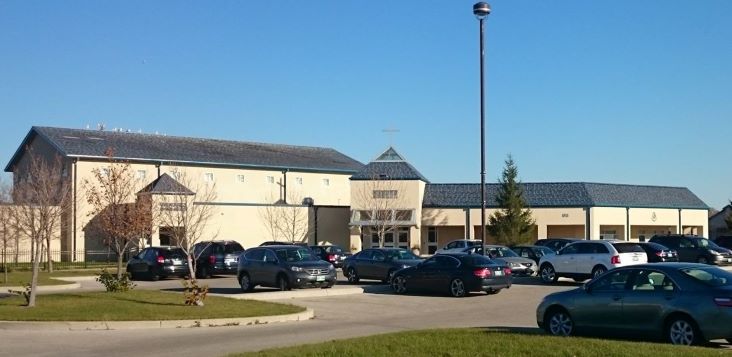Winnipeg I (Citadel)/Southlands Corps
On the 10th day of December 1886 at 43 ° below zero The Salvation Army opened fire in Winnipeg. "The North-West Brigade", a group of three men and three women, namely Staff-Captain Young, Lieutenant Archer, Captain Hackett and Captain Harrison and cadets Tierney and Graham had been sent from Toronto by train to commence the work in Winnipeg. The first act after setting foot on the station platform was to kneel and offer thanks to God for their safety and to seek an outpouring of His Spirit as they committed themselves for self less service on the great prairies.
Carter, hotel keeper of the Clifton House near the C.P.R. Station, was deeply impressed by this act and shortly after got saved.
A telegram was dispatched on December 13, 1886 to headquarters in Toronto:
"Secured Victoria Hall. Opened fire yesterday. Great crowd in open air and inside. Good order. One soul! Mild weather. Victory."
D.O. Young.
The whole party focused their attention on Winnipeg for a few weeks, after which Captain Harrison and Lieutenant Archer farewelled for Brandon. Captain Mary Hackett, who came originally from Belfast, Ireland, was left m charge as the first Corps Officer with cadets Tierney and Graham assisting. After seven months she farewelled to Victoria, B.C., and Captain Harrison after a successful seven months at Brandon came to Winnipeg to take charge with Lieutenant Harry Greatrex assisting, to be followed later by Cadet McGill, who came from a farm on the Souris River via the Brandon Corps. For the first time the tambourine was heard, and people began to talk and wonder. Good crowds attended the meetings and Victoria Hall was found to be much too small. Of the meetings, the Daily Sun reported. “Blood and Fire was proclaimed, and soon the victims began to drop, first one and then two or three, and gradually they fell so quickly that a bakers dozen was esteemed as only a fair night."
The very first convert was William Wood, an Englishman. He developed rapidly as a Salvationist, became a band man and played a Cornet up to the time of his Promotion to Glory, about sixteen months after his conversion.
Almost immediately after the Army's commencement, William Vinall started the first Corps Band with his sons. Families associated with the Army in those early beginning years were· the Habkirks, Yetmans, Chapmans, Johnstons, Nelsons, and McKenzies. In the flrs.t ten years there were three bandmasters: William Vinall, Alec Duncan and Bob Cantelon. Thomas Richardson was Corps Sergeant Major; Fred_ Ellis, Flag Sergeant; Dan Sewell, Doorkeeper; Mrs. Suggitt, War Cry Sergeant; and William Nelson was the Drummer.
The first and chief open air stand was the market square, just opposite City Hall, on Main Street. The fall of 1896 brought about a great soul-saving effort, :The Siege of The Lost”. Each soldier was made responsible for individually winning one soul and following them up to enrollment. Bandmaster Hector Habkirk was successful in bringing twelve for enrollment. The Corps Roll numbered approximately two hundred and “The siege” considerably increased it.
The Outstanding features of 1898 included the visit of the Founder, General William Booth and his party, including Colonel Lawley, and Commander Eva Booth. The train was snow bound in the mountains and the campaign meetings were commenced without them.
Later that same year, The Klondike Party headed by Commander Eva Booth passed through Winnipeg and a special meeting was conducted. In 1900, a new Citadel was built and opened on the site of the former First Baptist Church. 221 Rupert Street. Adjutant D. McAmmond was the Corps Officer. The Victoria hall was later pulled by oxen to Selkirk where it was used by that Corps until the 1950’s.
During the leadership of Adjutant and Mrs. John McElhiney the Corps experienced its most fruitful years of soul saving. The Winnipeg Theatre was packed on Sunday night with overflow meetings in the Citadel on several nights. Mrs. John Mitchell was active in conducting Y.P. meetings for the young folk. Through her hard work and efforts funds for instruments were raised and the famous Citadel Boys Band under Bandmaster Joe Dancy came into being. This aggregation included Billy Pearce, Percy Merritt, Jim Irwin, Roy Walker, Frank Bailey, Bill Sommerville, Joe Chapman, Charlie Donnelly and Jimmy Poole, to mention but a few.
The outbreak of World War I saw over 100 people connected with the Corps involved in the services. Colonel John Lawley and General Bramwell Booth visited the city in 1920 with meetings being held at the Old Board of Trade building. Five Hundred pairs of shoes given away at the New Year's Day service, 1921 at the Citadel. The Citadel Band under the leadership of Henry Merritt toured the east and held the audience at Massey Hall, Toronto 'spellbound'. "The Band soared to dizzy heights and merited the loud and prolonged applause it received." Corps Cadet Brigade was reported to have had 30 members in 1925 and fifty-four soldiers added to the roll in the past year. The Corps motto was "Advance."
The Friday night United Holiness Meetings attracted such huge crowds that sometimes the Cadets of the Training College had to go out for an Open Air meeting to make room for more people. Ensign and Mrs. Collier came to the Corps in 1929 and times were somewhat difficult with the depression just beginning. However, they met the challenge of the times with new tactics which brought many new people to the Hall. The special feature each Saturday was "The Good Ship Joy" which appealed to crowds of men who filled the gallery. Great losses were experienced in 1932 when the Territorial Headquarters for the West was closed down as well as the Training College.
The Fiftieth Anniversary of the Citadel Corps was celebrated in 1936 with Major and Mrs. E. FaIle as the Officers. Over 500 attended the turkey supper forcing Percy Merritt and Jack Webster to scour the district and restaurants for more supplies. The Band under Bandmaster H. Merritt had an extensive tour of the United States and Canada. World War II again saw many from the Citadel leave home for the services. The first Citadel boy to be reported " Missing" and later "Killed in Action" was Jack Gillespie. The year 1945 brought an unexpected blow to the Corps in the promotion to "Glory" of Bandmaster Henry Merritt. The Open Air work at Market and Main continued to be eagerly accepted by the comrades and was rewarded by God in the salvation of souls at the drumhead.
The end of the war and on through the fifties was a time of re-building and regrouping. The Band, now under the leadership of Fred Merrett and the Songsters under the baton of Jim Simons, were active in visiting centres throughout the area, including Minnesota and North Dakota. A major change was seen in 1960 with the opening of the new Citadel and Divisional Headquarters building at 400 Colony Street. On December 3rd, The Lieutenant Governor, The Honourable Errick C. Willis, Q .C. , and Commissioner W. Wycliffe Booth, L.L.D., Territorial Commander for Canada and Bermuda officiated. Major and Mrs. C. Gillingham were the Corps Officers at the time. The Rupert Street building became the home of the new Harbour Light Corps
The Senior Band and Songster Brigade continued their much appreciated ministry at home and abroad. Of particular note was the Band’s visit to Toronto in 1961 for participation in the Spring Festival. A thriving Youth Band under the leadership of Sandy Murray also enjoyed numerous opportunities of travelling throughout the area. The Citadel also boasted the Territories largest Corps Cadet Brigade in 1961 under the leadership of Mrs. Herb Besson.
In 1985 a mini-bus was purchased to enhance the Bus Ministry.
CANADA AND BERMUDA TERRITORY
Winnipeg I (Citadel)/Southlands Corps

Status: Open
Date Opened: December 10, 1889
Associated Locations: Southlands
Website: https://www.southlandschurch.com/
City: Winnipeg
Province: Manitoba
Division: Prairies
Type of MU: Corps (Church)
First Officer: Captain Mary Hackett
Current Officer: Major Wendy Mouland
CANADA AND BERMUDA TERRITORY
Click here for the a complete list of all Corps/Churches
Part of a series on:





